We’re excited to share the next member of the AltMill family with the AltMill 4×8. This has been a big collective effort to bring a well thought out, productive and affordable full format CNC machine to the hobby market.
The AltMill 4×8 launches for pre-order on Oct 29th. Stay tuned on our email list, blog and social media for more info. We will have a series of informative videos coming out during pre-order, including an in depth feature from our engineers. Plus, we have a Live Stream Q&A with our engineers scheduled for Thursday, November 6, 7pm to 8:30pm.
What is the AltMill 4×8?
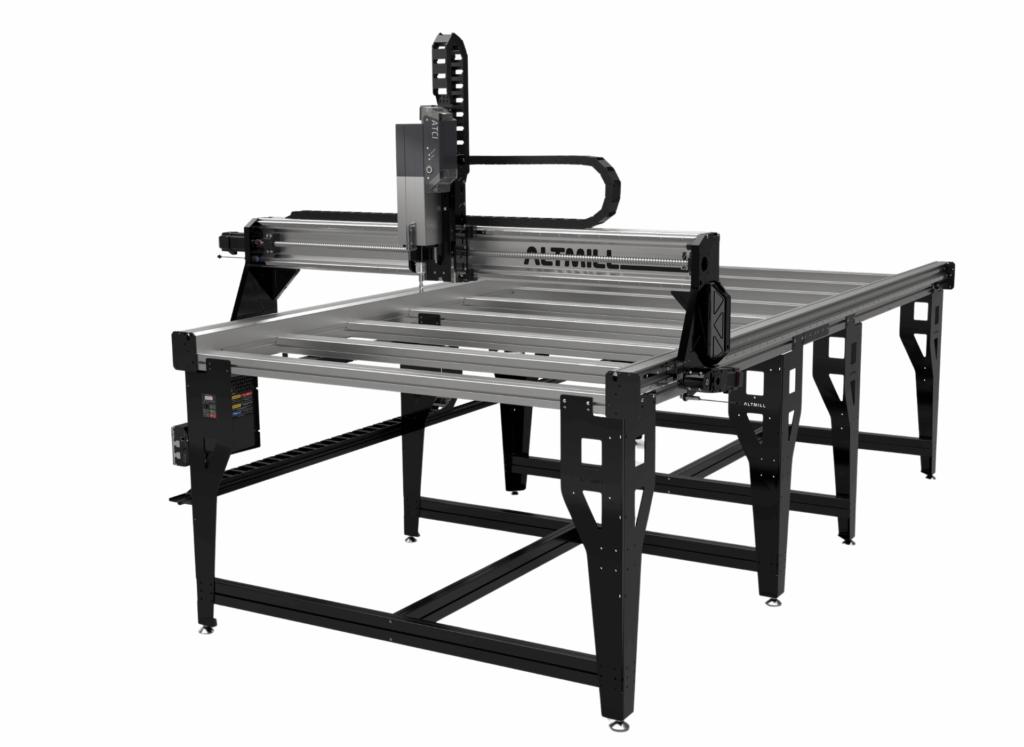
Our goal for the AltMill platform was to find the best balance between cost and performance, offering production level productivity at a price point affordable to beginners and hobbyists. The 4×8 variant takes this to the next step, allowing users to process full 4ft x 8ft sheet materials.
The AltMill 4×8 has some similarities with the 2×4 and 4×4 sizes, but uses redesigned components to extend the Y axis travel to just over 8ft. The fundamental design of the original AltMill was scaled up to achieve high performance with a larger working area, including increased Z-axis travel and clearance.
The 4×8 format is especially important as it represents one of the most standard sizes used in professional and industrial shops, for most materials like plywood, MDF and plastics. We expect more users to focus on building a business and scaling up their work for making money with this type of machine.
Who is the AltMill 4×8 for?
The AltMill 4×8 was designed at a price point that makes it accessible to the hobbyist and prosumer user, but it has the rigidity and precision capabilities that align with production and industrial focused machines. This makes it suitable for people who are intermediate or advanced hobby CNCers intending to scale into a business; or people who are already running a business and want to supplement or augment their existing production capacity. Entry level hobbyists will need to undergo a learning curve, but luckily we have year-round support and industry-leading resources to guide users on their journey. Learn more here.
Differences Between Industrial Machines & the AltMill 4×8
Software & Programming
For the most part, the CAM processes for both types of machines remain identical. Any CAM software you use for industrial machines can be used with the AltMill. Some industrial machines have more advanced software features on the CAM side, such as version control, managing stock of materials, and distributing jobs between multiple machines. Some software may need specific machines to do these functions, whereas some software is machine agonistic. These are advanced features found on very, very high production machines.
For controlling and sending gCode to your machine, some industrial machines use a custom interface, while some use a third party interface. Common ones include UCCNC, Centroid Acorn and Mach 3.
We offer official support for the AltMill with gSender, our free, actively developed, and powerful gCode sending software. If you’ve already used one of our other machines or used your machine with our software, you’ll already be familiar with it.
Speed
We’ve seen a pretty wide range of advertised speeds in the industrial machine space, with rapids from a few hundred to thousands of inches per minute. There are a few practical limitations to speed. First is bit deflection. In the industrial machine, the deflection of the end mill plays the largest role in the accuracy of the cut. This is a little bit different compared to the hobby space, where deflection of the structure of the machine generally plays a bigger role. Second is material or chipload limitations, or the amount of material the end mill can pull out based on the rotational speed of the bit and travel within the material.
The productivity of a machine is also dependent on the acceleration settings. Sort of like how a drag car might go faster in a straight line, but it can’t take corners as fast as an F1 car. Machines are the same. An industrial machine may not complete a job much more quickly than a hobby CNC in practice in some cases, for projects that require a lot of acceleration and deceleration.
In my opinion, it’s important for customers to consider unit economics. If an AltMill costs 5x less than an industrial unit, but cuts at half the speed, then getting two AltMills might make more sense than one industrial machine.
Cost
We generally would consider 4×8 machines under $15,000 to be in the hobby range, whereas industrial machines are generally above $15,000 and can run hundreds of thousands of dollars.
There are some industrial style CNC machines that can cost much less, typically built in China, but this generally doesn’t take into account the cost of shipping and importation, setup or modifications to work in North America which can cost more than the machine itself.
Buying Experience
Most industrial machines don’t have a single price and require the buyer to get a quote. This makes the buying process longer and harder for the average buyer to cross shop or compare pricing.
Our goal has always been to make pricing as transparent as possible. Pricing for all products are listed on the website, and shipping quotes can be automatically generated in the cart.
Shipping
Industrial CNCs almost always need to be shipped by freight. Depending on where you’re located, it can cost hundreds, if not thousands of dollars in cost to be able to get it into your shop. Additionally, you will likely need to have some method, such as a loading dock or forklift, to be able to unload and move your machine, which adds to the cost.
The AltMill on the other hand comes in a series of 6-7 boxes, which all get shipped by courier, and can be delivered to almost any resident or shop in the world. We estimate that the shipping cost for most parts of the US and Canada to be around $300-500 USD.
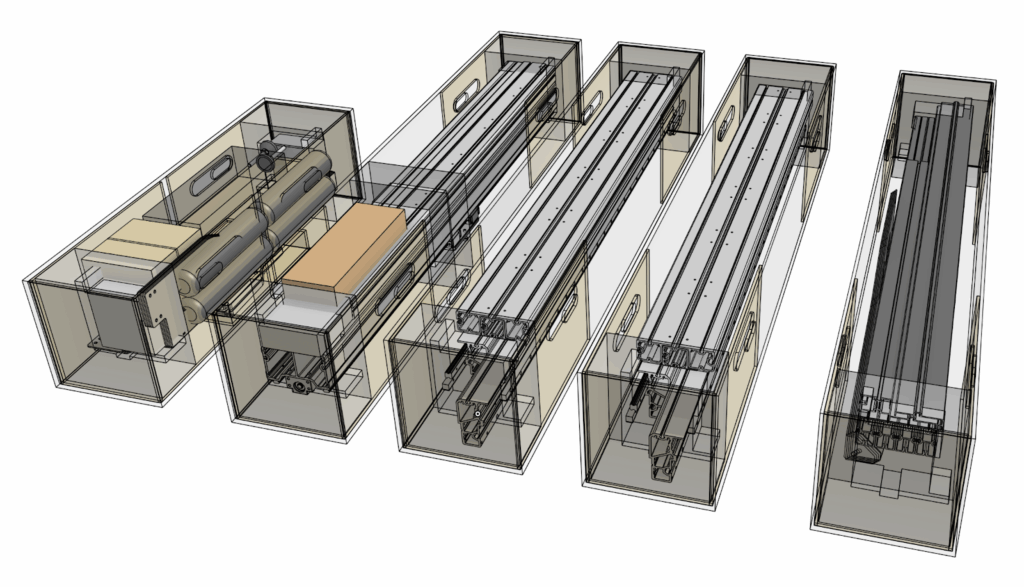
Weight
As we mentioned before, the weight of the machine impacts the shipping cost and acceleration settings. Another factor to consider is the ability for the user to relocate the machine. Industrial machines weighing thousands of pounds require special equipment to move, whether it be around the shop or to a different location. Additionally, many industrial machines need a special pad or mounting to the ground for stability and safety reasons. This can cost a few thousand dollars to install if it doesn’t exist in a shop yet.
The upside of having a heavier machine is that it absorbs vibrations, which means that cuts can come out smoother and with less chatter. However, a heavier machine also requires more energy for it to move its axes. This means larger motors, bearings, and other hardware, offsetting some of the benefits of having a heavier frame.
The AltMill 4×8 weighs several hundred pounds and simply uses levelling feet to work with the typical shop or garage. This makes it easier to move around and ship. Although it may not have as much vibration dampening capacity, we believe that it provides more than enough rigidity to get clean and accurate cuts. It’s important to note that the AltMill is designed for cutting woods and plastics primarily, which is considered a fairly soft material.
Features
There are a lot of features that are found with both hobby and industrial machines, but are usually more common or standard on industrial machines. For example, automatic toolchangers and vacuum tables and hold downs are generally more common options that are built in mind for the system.
At the moment, the AltMill ecosystem does not have every feature to match industrial systems. Some of these features can be added with 3rd party kits from other manufacturers. That being said, we’ll likely work on new features, especially for the 4×8 machines, since we expect more customers to be production focused as time goes on.
Power Requirements
The larger the machines are, the larger their power requirements typically are as well. With the AltMill, the machine itself can run off 110V power from your outlet, but we expect a lot, if not most customers will want a 220V spindle as the 110V spindles may be underpowered. If speed is not your concern and you don’t mind running your machine slower, while being able to not need any additional electrical work, the AltMill is still a great option for a budget friendly 4×8.
Because it’s expected for industrial machines to be used in industrial settings, which typically have access to 220V and even 3 phase power, industrial machines likely will use higher power input options that typical hobbyists don’t have in a home shop or similar.
Maintenance
The more expensive and complicated a machine gets, the more likely it is to require more expensive maintenance. At minimum, all machines need proper lubrication on all moving components including the linear motion systems, power transmission, and bearings. Industrial machines may require service by a technician or specialist for maintenance and repairs.
Maintenance on the AltMill on the other hand is designed to be done by the user, which means that it can be done without the need to schedule a service. Additionally, parts for replacement are relatively inexpensive. Because there is a self assembly portion of the machine, users also get an opportunity to understand the workings of their machine better.
Engineering
The engineering of the 4×8 combines development and innovations from the other AltMill versions and adds on top of it.
Linear Rail, Rack and Rail Coupling
One of the main challenges of bringing a 4×8 form factor machine to market is getting it to the end user. Simply put, limitations to the size and weight of packages shipped through courier cannot allow linear motion components used in the Y axis to be shipped in a single piece, unlike with the 2×4 and 4×4 machines. This means that these components need to be aligned and coupled together by the user. A significant amount of engineering was done to ensure the smooth and accurate coupling of these components.
Some designs and innovations in this space include developing:
- A special bracket and process for joining the two lengths
- Adjusting the spacing between linear motion parts and tolerancing to reduce the impact of gaps in between components
- An easy to follow process to reduce assembly error
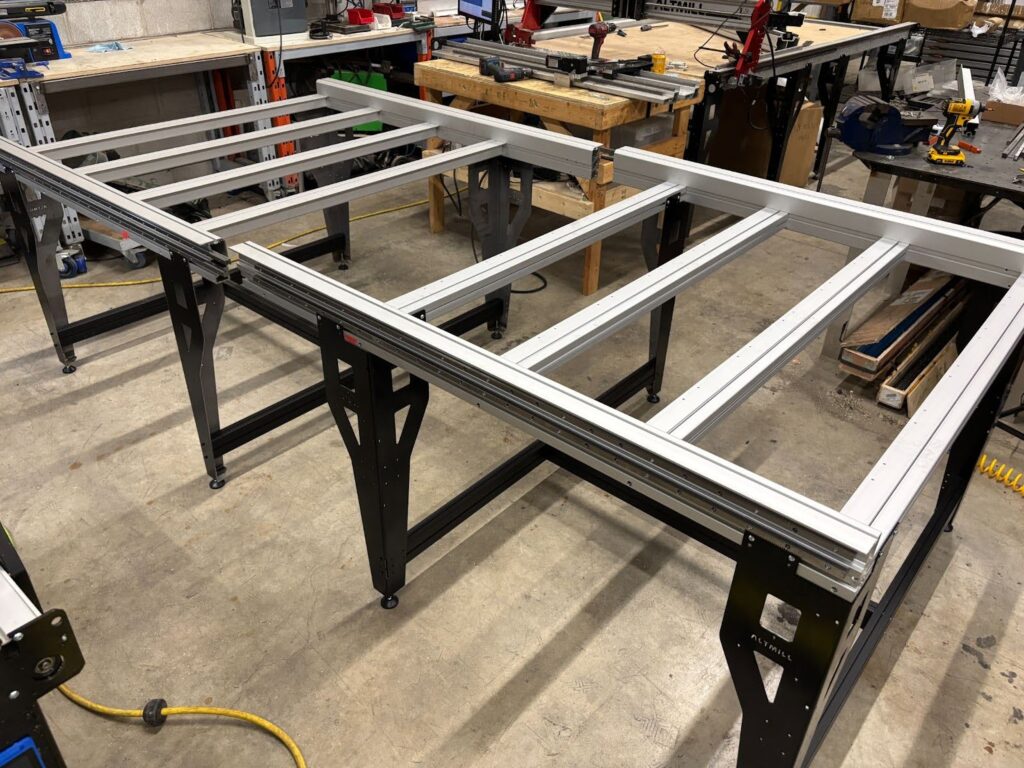
Rack and Pinion Engineering
A big debate when it comes to choosing rack and pinion versus ball screw has revolved (haha) around the accuracy and precision differences between both tools. While ball screws can generally achieve higher precision, ball screws come with several downsides that make them less accurate over longer distances.
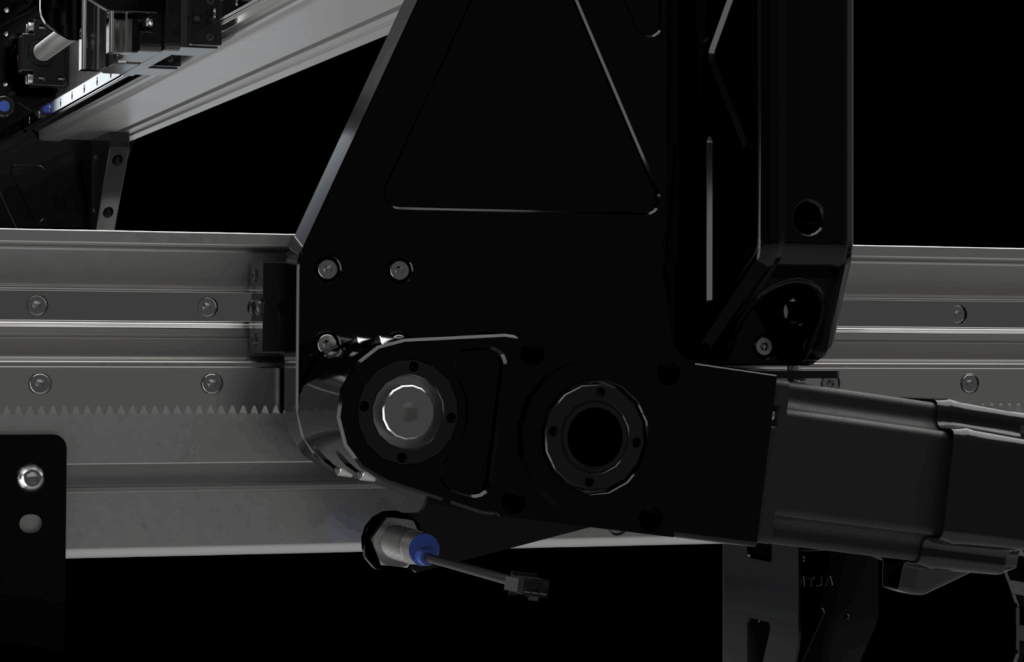
First is that a longer ball screw can flex more easily. Since the ball screw is only secured at each end, it means that it can bend from cutting forces. This also can be exacerbated with any whipping that happens, which can introduce vibrations and limit the speed of which the machine can move.
Rack and pinion on the other hand is mounted along the length of the rack. This means that there is much less flex in the system.
Additionally, ball screws cannot be joined together. Due to shipping limitations, the Y-axis parts must be separated and shipped in segments. Since racks can be butted together to make longer racks, this is not a problem with rack and pinion.
It’s also important to note that the theoretical differences between rack and pinion are more relevant in very high precision applications such as commercial vertical machining centers, and less so in the application of CNC routers, where your material and cutting tool is more likely to influence the accuracy of your parts.
Wear and Hardness Testing
We have conducted a significant amount of testing and research to ensure a high degree of longevity of the rack and pinon system. Much of this came down to understanding the effects of hardness between the rack and pinon. We’ve explored many aspects of the materials used for the rack and pinion including:
- Post processing the parts including nitriding and heat treatment
- Working with different alloys
- Adjusting the gear profiles
- Long term testing of the use of different lubrication
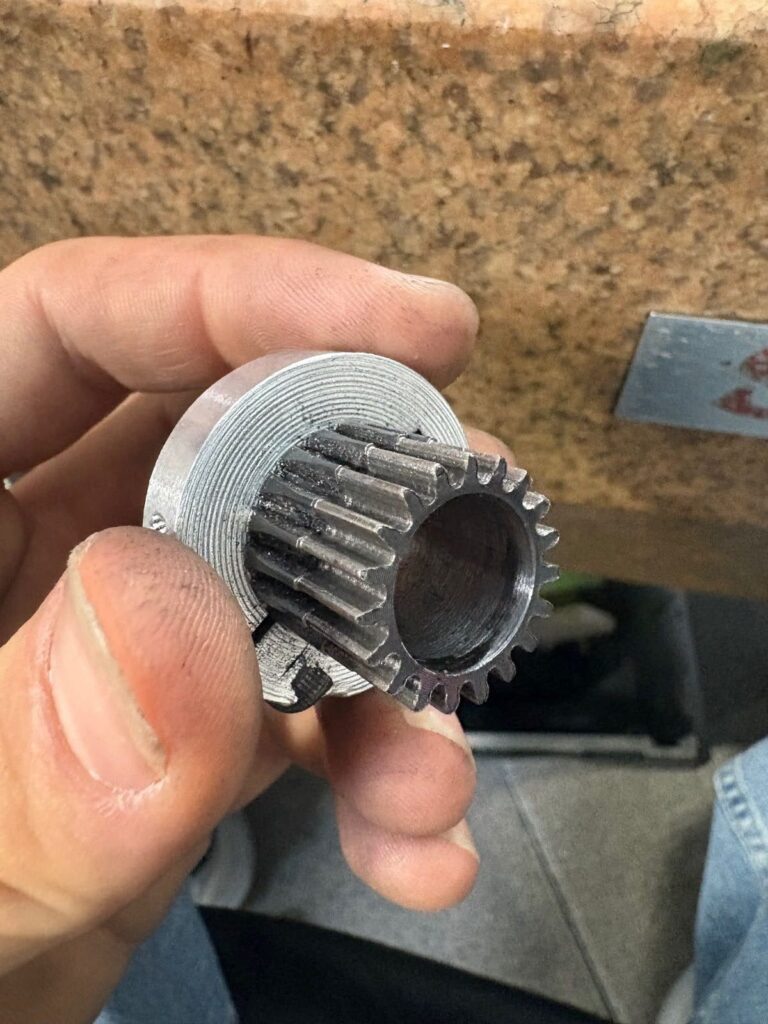
Pinion Tensioning System
To ensure proper meshing of the pinion to the rack, we’ve also developed our own pinion tensioning system, which allows for the pinion to have the proper preload for eliminating backlash against the rack and adjusts for wear over time. This also allows for slight misalignments and tolerances in the machine and assembly process.
Gearing
To ensure high levels of precision, the motors are geared down to increase torque and increase resolution of the motor. We found that stepper motors also have a small amount of “elasticity”, which means that when they are held stationary, they can turn very slightly when a load is applied. Given the lower friction and higher distance to rotation ratio, this effect makes a bigger impact to the precision of the machine position while it is stationary. By gearing the motor down approximately 5:1, it effectively reduces the impact of “elasticity” as well.
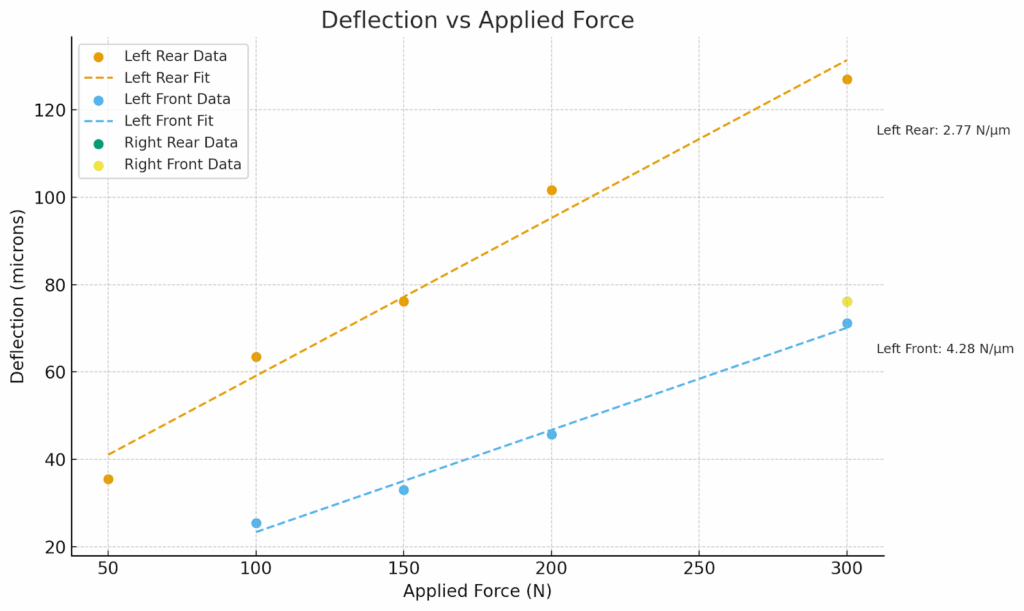
Spindle options
The AltMill 4×8 will work with 1.5KW, 2.2KW ER20 spindles,, and our up and coming ATC spindle and natively support a toolchanger. 1.5KW and 2.2KW spindles are identical to the ones used on the 2×4 and 4×4 except with a longer spindle cable.
ATC
For those who don’t know, we have been actively working on an ATC spindle. We’re wrapping up development and production, but here’s some details to share before we do a full announcement:
- Price: 2500USD-3000USD
- ISO20 toolholders with ER20 collets
- Capable of expansion up to 12 slots/tools
- 220V, 2.2KW
- Air-cooled via low-noise electric fan
Users must provide an air compressor and dryer (such as a desiccant dryer). The ATC has been developed specially to be compatible with most consumer grade compressors (around $300).
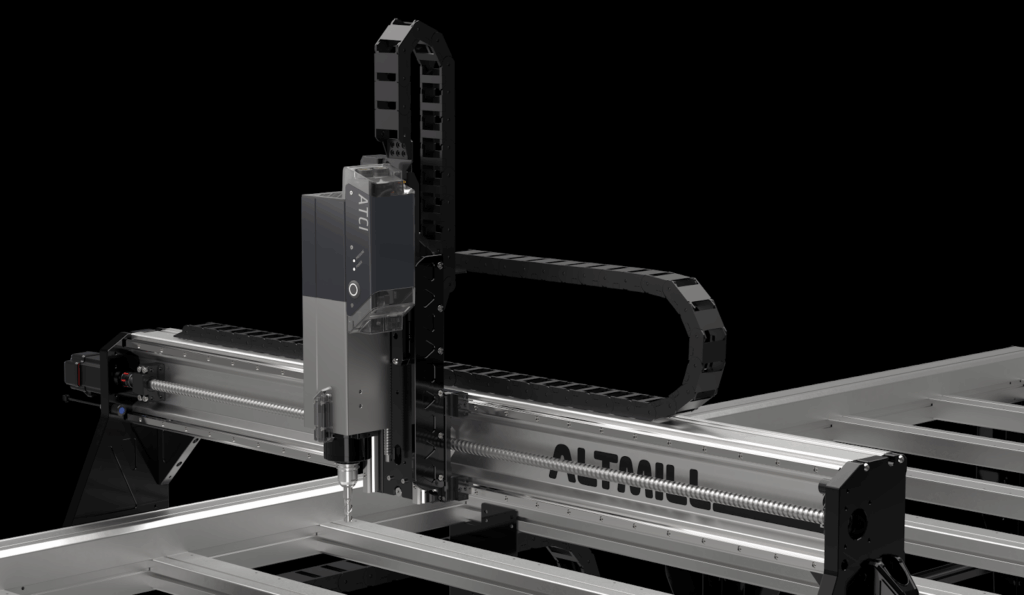
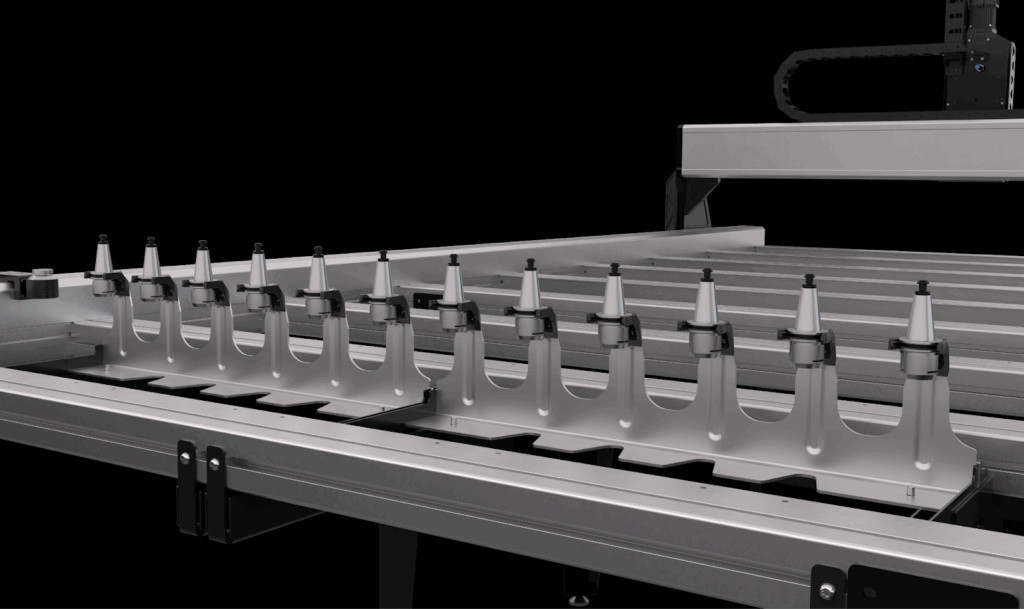
Our ATci is specially developed as one of the most integrated, advanced, and beginner friendly ATC systems, with features including:
- Plug and play operation, with native integration with gSender allowing easy re-mapping/selection of tools for a given job
- Advanced safety features, including integrated: pressure sensing; temperature monitoring; tool in spindle check; and tool in rack sensing to monitor the state of the spindle at all times
- Easy to remove toolrack to allow users to switch to allow passthrough/tiling operations
- Designed for quietness. Low noise cooling fans and air seal that turns off when not in operation
We are expecting to do a full announcement and launch in November.
Production Schedule
Batch 1
We are building approximately 150 AltMill 4×8 in the first batch. We expect units from this batch to start shipping mid-Feb to early March 2026.
Pricing
Pricing for the AltMill 4×8 without a spindle will start at $7,490USD/$10,390CAD. Spindles can be purchased and configured to the user’s needs and will have different pricings.
Shipping will vary based on location, but customers should expect to pay between $300-500USD in shipping within North America.
FAQs
How much do I need to pay upfront?
A full, 100% payment for the AltMill 4×8 is required to hold your place in line. Customers may cancel and get a full refund for their machine anytime before their machine ships.
Will there be any upgrade path to a 4×8 from a 2×4 or a 4×4?
It is under consideration but it will not be a priority for us to provide an upgrade path. First, given that so many additional new components are needed to go to a 4×8, the cost difference between the upgrade kit and the full kit will not be that significant. Additionally, there is a significant overhead cost to do version tracking and ensure compatibility between machine versions that will add to the cost of the kit. It’s likely that it will be more cost effective and reduce waste if customers sell their existing machines and order a full machine.
Eventually we will have parts available for purchase which allows us to pave the way for a potential modification or upgrade path, but this will not be available until later next year.
Are you going to make a 5x10ft AltMill?
Not until we get the 4x8ft machines out the door first. But if we get enough interest or demand, we may consider it.
Will the AltMill 4×8 work with an ATC?
We expect to have our ATC system available for pre-order closer to the end of the year. However, the ATC system will be compatible with all AltMill variants and will ship around the same time as the first AltMill 4x8s start shipping.
If you’re ordering an AltMIll 4×8 before all of the spindles are available, we recommend placing your order for one closer to when your machine is slated to ship.
What are the power requirements of the AltMill 4×8?
All AltMills use a 110VAC, 48VDC 10A power supply, consuming up to 500 watts. The power supply comes with a North American Standard Type B NEMA 5-15P plug.
Users will also need to account for power use from the spindle, which have separate specifications.
How big is the AltMill 4×8?
The footprint of the AltMill is approximately 114″ long x 66” wide, and over 66” tall (when including spindle height).
[…] The AltMill 4×8 is now available for pre-order! You can now order it on the product page. If you want to learn more about the product itself and what it stands for, make sure to read our article, Everything You Need to Know About the AltMill 4×8 […]